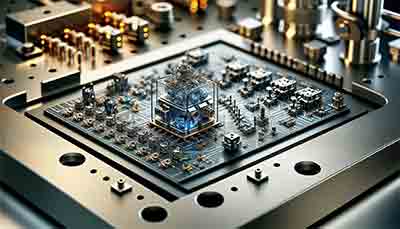Do you have any 2" float zone HR Si (>10,000 ohm-cm) that is 2mm or thicker? Has to be both sides polished. They will be used to research material science, particularly characterization of silicon and its properties under various conditions. We need the ample material for testing and analysis.
HR Thick Silicon Wafers for Material Science Studies
A PhD candidate requested a quote for the following:
Reference #115258 for specs and pricing.
High Resistivity Silicon Wafers (HRSI)
High wafer resistivity HRSI are used for Radio Frequency (RF), MEMS and dielectric wave guides, resonators.
Below is one of the wafer items we have to help you.
FZ, Intrinsic, TTV<5um, Bow/Warp<30um, 2 SEMI Flats
unused HRSi wafers remained after R&D project to sell:
100 mm diameter
double side polished,
250 um+-5 um thick
20,000 Ohm*cm (undoped)
Please let us know if you can use or if you need another spec?
Get Your Float Zone Silicon Wafer Quote FAST! Or, Buy Online and Start Researching Today!
Why High-Resistivity Silicon Wafers?
High-Resistivity Silicon Wafers have attracted the attention of both consumers and suppliers due to their unmatched features. Intrinsic, or unstipulated, wafers are among the most popular, durable, and inexpensive flat surface materials in the industry. They can withstand extreme conditions, including high temperatures, extreme temperatures, and extreme humidity. With their flexible structures, they offer a great deal of customized performance and versatility.
Why is Substrate Resistivity Important
Resistance is very important when you try to build good devices and produce uniform thermal oxides. The more evenly the thermal oxide grows, the better the performance of the device and the less resistance it generates.
We understand that the uniformity and resistance of a starting material is directly related to the growth of oxides, but how does it work?
If the dosing uniformity of the starter wafer is good, we can expect good thermal oxides. Of course we are transforming this, but the growth of thermal oxide works just the same: it is just a matter of a little more time.
As you can see, epitaxial wafers are not always the best choice for uniform thermal oxides: ingots can have resistance problems, as can wafers. We maximize the wafers and observe a change in the heat oxide concentration of the ingot from 3 cm2 to 3.5 mm2.
Watch https://www.youtube.com/embed/I9RmGM1kbs8
Fluorite Semiconductor Lithography Equipment
Please let us know if you have any questions regarding this equipment.
Do you need high resistivity soi?
What Silicon Wafers are Used for Terahertz Photonic Crystal Cavity?
The silicon wafer is a common substrate in the fabrication of terahertz photonic crystal cavities, which can be fabricated using the conventional manufacturing process. A photonic crystal cavity is a structure in which a crystal has three holes on its principal axis and an associated lattice constant. It is constructed to have a shunt impedance that reflects incoming waves. The shunt impedance is a transmission line of characteristic impedance, and the incoming wave is partly transmitted in a vacuum.
A scientists requested high-resistivity (HRFZ) silicon wafers to pattern them to form a terahertz photonic crystal cavity.
Specs requested:
Do you have silicon wafers below? (i) 4pcs, 3", 70um thick, HRFZ: resistivity > 10000 ohm cm, <100>, DSP (ii) 2pcs, 3", 50um thick, HRFZ: resistivity > 10000 ohm cm, <100>, DSP
UniversityWafer, Inc. Quoted:
3" 70um thick, HRFZ: resistivity > 10000 ohm cm, <100>, DSP
3" 50um thick, HRFZ: resistivity > 10000 ohm cm, <100>, DSP
Please reference #265492 for pricing.
What Inventory of High Resistivity Silicon Wafers Do You Have?
High resistivity silicon wafers are the most efficient semiconductor substrate on the market. They offer a long-term solution to heat-resistant and insulator challenges, making them ideal for thermal insulators with longer service life.
UniversityWafer, Inc's high resistivity undoped silicon wafers are used to produce the most efficient semiconductors. They also offer a source of energy for electronic and non-electrical devices. Why wait? Buy Undoped Silicon Wafers.
What are Some Features of Float Zone Silicon Wafers?
High resistivity silicon wafers are required for passive components in millimeter-wave and microwave systems. They are also used in advanced telecommunication systems. They enhance the performance of passive components and are an ideal choice for RF-CMOS process technologies. Several advantages can be derived from high resistivity silicon wafers. Here are a few: They can support advanced wafer characteristics, which make them attractive materials for RF-CMOS process technology.
7 Applications That Use Thick High-Resistivity Silicon Wafers
2mm thick high resistivity silicon wafers are used in various advanced research applications due to their specific properties. Here are some examples of research areas that utilize these wafers:
-
High-Frequency Electronics: Research on high-frequency electronic components, such as RF and microwave devices, often employs thick high resistivity silicon wafers to reduce signal loss and improve performance.
-
Radiation Detectors: In the development of radiation detectors, particularly for medical imaging and high-energy physics experiments, thick high resistivity silicon wafers are used for their ability to withstand high levels of radiation without degrading.
-
Power Electronics: Studies on power electronic devices, such as high-power transistors and diodes, utilize thick silicon wafers to handle high voltages and currents, while maintaining low power loss and high efficiency.
-
MEMS and NEMS Devices: Research in microelectromechanical systems (MEMS) and nanoelectromechanical systems (NEMS) often requires thick silicon wafers to provide structural support and maintain mechanical stability for miniature sensors and actuators.
-
Acoustic Wave Devices: High resistivity silicon wafers are used in the development of acoustic wave devices, such as surface acoustic wave (SAW) and bulk acoustic wave (BAW) devices, for applications in filters and resonators in communication systems.
-
Optoelectronic Research: In optoelectronic research, thick high resistivity silicon wafers are used for fabricating photonic devices, including photodetectors and solar cells, where their high resistivity helps reduce electrical noise and improve device performance.
-
Material Science Studies: Research in material science, particularly in the characterization of silicon and its properties under various conditions, often employs thick wafers to provide ample material for testing and analysis.
These applications leverage the unique properties of 2mm thick high resistivity silicon wafers to advance technology and scientific understanding in various fields.
Five Application for High-Resistivity Silicon Wafers
High resistivity silicon wafers are used in various advanced technology applications due to their electrical insulation properties and high purity. Here are five key applications:
Radio Frequency (RF) Devices
High resistivity silicon wafers are used in RF devices and components, such as RF switches and RF power amplifiers, due to their low signal loss and excellent performance at high frequencies.

Microelectromechanical Systems (MEMS)
In MEMS projects, these wafers are critical because they have high resistivity. This property cuts down on electrical interference and keeps device performance sharp. MEMS devices are packed with tiny sensors, actuators, and other small mechanical parts that work together on a micro scale.

Power Devices
High resistivity silicon wafers are employed in the fabrication of power semiconductor devices, such as diodes, transistors, and thyristors, which require high voltage and current handling capabilities without significant power loss.

Photonics and Optoelectronics
In photonic and optoelectronic applications, high resistivity silicon wafers are used to create devices like photodetectors, light-emitting diodes (LEDs), and laser diodes, benefiting from their ability to reduce electrical noise and improve signal integrity.

Silicon-on-Insulator (SOI) Technology
These wafers serve as a substrate in SOI technology, which is used to manufacture high-performance and low-power integrated circuits. In today’s tech landscape, SOI wafers are indispensable. They support everything from sophisticated microprocessors to fast-paced RF circuits, along with many other rapid digital and analog devices.

High Resistivity Silicon Wafers
High Resistivity Silicon Wafers (HR-SOI) are a prime component of infrared detectors. These wafers enable multi-mode functionality and increase data speed. The market for HR-SOI has been growing due to the increasing demand for consumer electronics. Its demand is also fuelled by the growth in the W-Fi industry and the growth of multi-mode functionality. The demand for high resistivity silicon is expected to increase, especially in China, which is the manufacturing center for consumer electronics.
The global High Resistivity Silicon Wafers market is characterized by its uniform distribution. Companies that are positioned in a low-cost region may not have as much demand as those in a high-cost area. In addition, low-cost regions may not have enough supply to keep prices competitive. Additionally, a high demand for precision wafers in such regions can increase the cost per piece. This makes it important for manufacturers to invest in manufacturing facilities in countries with low costs.
What is The Market for High-Resistivity Silicon Wafers?
Various manufacturers are operating in the high resistivity silicon wafers market. They are vying for a prominent position in the market. These manufacturers are investing heavily in R&D activities in order to enhance the quality of their products. The report also highlights the latest developments in the industry and the competitive landscape. Moreover, the report covers the product rate, production, supply, and growth in different regions. The High Resistivity Silicon Wafers market is anticipated to grow at a significant pace over the next eight years.
There are several leading players in the High Resistivity Silicon Wafers market. Each of these companies is keen on taking a substantial portion of the overall market. The report also highlights their key strategic initiatives, innovation, and technological advancements. A thorough study of the High Resistivity Silicon Wafers industry will help you select the right company for your business. In this competitive environment, it is critical to choose the right partner to help you grow your business.
The study analyzes the high resistance silicon wafers market and provides an analysis of the market. It presents the key market dynamics, challenges, and structure. In addition to the main characteristics, it also includes a projection for the growth of the industry during the period 2020-2030. Further, the study includes a value chain analysis, compound annual growth rate, and other vital information. These findings can help you interpret the qualitative and quantitative aspects of the high resistivity silicon wafers market.
In addition to studying the High Resistivity Silicon Wafers market, the report also examines its competitive landscape. It examines the major regional and international locations, and the SWOT and investment feasibility of the different vendors. The report examines the fundamentals of the High Resistivity Silicon Wafers industry. In particular, it discusses the product rate and production, supply, and the competitive environment. The research provides a thorough understanding of the market for the High Resistance Silicon-Wafers.
In addition to examining the current market situation of the High Resistivity Silicon Wafers market, the report also looks at the potential market opportunities in this sector. There are several high-resistance semiconductor markets around the world, including the United States, Europe, and Asia-Pacific. Among these regions, China is the largest market for this product, with Asia-Pacific dominating the overall market. The regional trends of the High Resistivity Silicon Wafer industry are outlined in the study.
The High Resistivity Silicon Wafers market is segmented based on the end-use industry and geography. The Asia Pacific region is expected to grow at the fastest rate, owing to the large consumer electronics market in China and growing manufacturing capacity. However, the market for High Resistivity Silicon Wafers is likely to grow even faster than the average in the integrated semiconductor wafer industry. There is a wide range of applications for these semiconductors.
To make high-resistivity semiconductors, manufacturers must first produce a high-quality silicon wafer. The higher the resistivity, the better. This type of semiconductor is expensive. Hence, it is crucial to find a supplier that offers these devices at the most affordable prices. In addition, the company's quality control and reliability is an integral part of its operations. The quality of a silicon chip depends on the process it uses.
How are High-Resistivity Silicon Wafers Made?
The best quality high resistivity silicon wafers are made by reducing the amount of oxygen on their surfaces. Oxygen precipitates on the surface of test samples. The resulting high resistivity is measured using different techniques. A typical 0.6203 mm test sample is heated for eight or sixteen hours before being evaluated. The results show a good relationship between the degree of machining and the total carbon percentage on the surface of the silicon.
The most desirable characteristics of high resistivity silicon wafers are low carbon and nitrogen concentrations. The highest resistance silicon is made from float zone growth technology. This method provides uniform and controlled oxygen distribution throughout the wafer. Further, the best-performing high resistivity silicon is highly flexible and is suitable for many applications. The most important application for high resistivity silicon is the manufacturing of semiconductor devices. A wide range of applications is possible, including solar cells, photovoltaic panels, and photovoltaic cells.
The highest resistivity silicon wafers have an interstitial oxygen concentration of 8x1017 atoms/cm3, BMD density of 5x107 pieces/cm3, and electric resistance of 100 O*cm. This material is ideal for applications that require high frequency signals and are susceptible to noise. This high resistivity silicon wafer is a good solution for signal attenuation and noise problems. In addition, high-frequency silicon wafers are used in wireless communication systems.
The highest resistivity silicon wafers are used as base wafers for silicon wafers. They can be epitaxial or SOI structures. The mechanical strength of high-res silicon wafers is 100 O*cm. The two characteristics are essential in semiconductor applications. These properties are essential for the production of electronic circuits. A large number of different kinds of semiconductor devices uses this material. It is not uncommon for transistors to have a COP of 8.
High resistivity silicon is the most common semiconductor. It is a base wafer for high-resistance silicon. They can be epitaxial or SOI, and have a high-resistance n-type structure. This material can also be epitaxial or SOI. These structures are useful for a variety of other applications. This material is used in the manufacturing of electronic equipment. Aside from semiconductors, it can be incorporated into devices such as microelectronic chips.
High resistivity silicon wafers can be used for the fabrication of semiconductor devices. These products can be used as base wafers for SOI chips. The main advantage of high-resistivity silicon wafers is that they can be used for mobile communications. In addition, they are advantageous for the manufacturing of optical circuits. The resistance of such devices is also a factor in their manufacturing. However, the process for high-resi transistors is complicated because of their multiple layers.
The high resistivity silicon wafers are used for various applications. The materials are ideal for thermal insulators with longer service life, and they are often used in high-precision work. They also offer a long-term solution to heat-resistant and insulator challenges. In this way, the high resistivity silicon wafers are used to produce the most efficient semiconductors. The materials are also a source of energy for electronic and non-electrical devices.
High resistivity silicon wafers are typically used as base wafers in semiconductor production. The high resistivity silicon wafers have an epitaxial or SOI structure. For example, FIG. 1 shows the representative distribution of grown-in defects (faults) in a single crystal. The elasticity of silicon is proportional to the density of atoms. In other words, the mechanical strength of a silicon wafer varies according to the type of crystal.
To produce a high-resistance silicon wafer, a thin layer of Gold (Au) is used. The Au dopant has a low electrical resistance, which reduces RF losses. The n-type silicon is less susceptible to intermodulation, which reduces the frequency of signal processing. A higher-resistance n-type semiconductor is more robust and is more durable. If the n-type Cz-Si is used, it is important to consider the thickness of the substrate.
High-resistivity silicon wafers are grown using the Float Zone (FZ) method. Undoped, and intrinsic are used to describe the wafers Their Unambent usage in the global high resistivity silicon wafer market includes flat, thin, and thin-profile products. They can be manufactured with small open channels for easy cooling and for variable speed drive applications. These flat, thin, and thin-profile products are often available in unstrained and constrained thicknesses. This makes them ideal for high volume production and to provide customers with a wide range of surface structures. They are available in many common and uncommon colors as well.
High-Resistivity Silicon flat wafer structures have been the subject of extensive research by key players in the semiconductor market including Intel, Niantec, Applied Digital, Fairtex, Omron, and Toshiba. Based on these extensive research and technology developments, some of the features of the latest ![]() generation of high-resistance wafers include advanced cooling systems, solid braid finish, and interlock fiber layering. The single side polished wafers, which have the most thorough testing of any wafer structure, are used in applications requiring high-temperature electronics, laser diodes, fused silica semiconductors, and/or infrared illumination.
generation of high-resistance wafers include advanced cooling systems, solid braid finish, and interlock fiber layering. The single side polished wafers, which have the most thorough testing of any wafer structure, are used in applications requiring high-temperature electronics, laser diodes, fused silica semiconductors, and/or infrared illumination.
High-Resistivity Silicon is predicted to be one of the fastest-growing segments in the integrated wafer manufacturing technology market during the forecast period. In anticipation of this growth, technology developers are designing products for a broad range of high resistivity applications including mechanical seals, electrical seals, mechanical bolts, electrical connectors, edge connectors, adhesive elastomeric seals, fiberglass electrical insulators, fiberglass shaft seals, and fiberglass shaft seals with metal inserts. Some of the highest-rated high resistivity silicon wafers are also being used in aerospace applications including sealants for fighter planes, aircraft airframes, and spacecraft. Some of the aerospace applications using high resistivity silicon wafers are wings, landing gear, landing gears assembly, shock towers, and aircraft ductwork.
Demand for High-Resistivity Silicon wafers is expected to continue to grow faster than the average growth rate of the total integrated wafer industry over the next five years. The increasing demand for high-resistance wafers has resulted in the development of a wide range of high-quality, low-cost, single or double-sided, precision machined products. The most popular products include precision thin-film soldered insulators, precision heat insulators, precision thermoplastic thermal insulators, and many specialty single or double-sided silicon products. The demand for these products has increased exponentially as customers have become more aware of the need to use a more durable insulator with reduced losses in cooling.
High-Resistivity Silicon wafers are being used for a variety of reasons. These applications include applications requiring a thermal insulator with a longer service life; products requiring an exceptionally tight fit; high-precision work that requires a unique shape. In order to provide an accurate prediction period for the global high resistivity silicon wafers market size, several different analytical methods have been developed over the past several years. Using one of these methods will give a more accurate estimate. Most analysis techniques assume a uniform distribution of manufacturing locations throughout the globe.
Using a uniform distribution of locations for global high resistivity silicon wafers will make it easier to determine the demand by region. If a company has an advantage in one location, it may have an advantage in another location. The location of a company's main production facility is very important to determine their demand in the global high resistivity silicon wafers market. Companies that have their production facilities located primarily in low-cost areas may not be able to tap into the large enough supply to keep their prices competitive. Low-cost areas tend to have a larger demand for precision wafers, which also tends to drive up the cost per piece.
Analysis using single side or double side polished flat lamination technology, as well as other common analytical techniques, may be able to provide a more accurate forecast of the global high resistivity market. Analysis techniques such as those mentioned above will require information about the specific lamination process used in each piece, the level of heat used during processing, and the thickness of the surface of each piece. Each of these pieces will need to undergo some sort of quality control test to make sure that each piece maintains the highest quality possible. Laminating machines can also be used to create a flat lamination profile if a company wants a more consistent result.
Soitec has launched its second generation of wafers, called eSI90, an improved signal integrity substrate. The carbon-doped amorphous silicon layer is a spilled oxide layer in which there is a layer of carbon dioxide (CO2). This is the first of its kind in the world and one of the most advanced silicon substrates available today. [Sources: 1, 5]
The silicon insulator structure [2] consists of two layers of buried oxides and a layer of carbon-doped amorphous silicon. It consists of a silicon layer with a buried oxide layer on the silicon and a carbon dioxide layer underneath. The silicon structure [2] consists of two layers of oxide, one of which is buried in the oxide material and the other at the top. [Sources: 0]
The high resistance of the silicon substrate [102] is deposited by a thin layer of silicon dioxide [108] and serves to prevent leakage of electricity from the substrate. This results in a lower substrate loss due to parasitic components and can be measured at microwave frequencies using a high - high-performance, low - cost and low - to noise ratio [109]. [Sources: 5, 7, 8]
N, the team used three types of silicon wafers for the experiments: N -phosphorus - doped, nitrogen - doped and silicon dioxide - doped. [Sources: 6]
N, the researchers used three types of silicon wafers for the experiments: N - phosphorus - doped, nitrogen - doped and silicon dioxide - doped. Phosphorus doping: The researchers used three types of silicon wafers for this experiment, with N-phosphorus doping and nitrogen doping being the main components. N they used all three types of silicone wafers: phosphorus dopters, nitrous oxide dopes and nitrogen dioxide dopters. [Sources: 4]
The electrical resistance is 100 o / cm or more, also called ano, and corresponds to a silicon wafer with an electrical resistance of 100 - 100%. The electrical resistance in it is equal to or greater than a 1.5 o / cm2 silicone wafer, which refers to a a5x105 piece or a 10x10 cm2 silicone wafer. [Sources: 9, 11]
According to the present invention, BMD (Bulk Micro Defect) requires a dense oxygen loss of the waferato of 5a107 pieces per cm3 or less. It is also necessary if there is a 5x107 piece of Percm3 or less, and it is necessary to require a BMD (Bulk Microdefect) according to our current inventions. [Sources: 9, 11]
Dale Margrave has shown that silicon difluoride can be obtained in the wafer with an oxygen loss of only 2.5 - 3%. Using this loss, the value is quaked by improving the tangent of silicon oxide by 6 - 10.3% to stoichiometric silicon dioxide. [Sources: 8, 10]
Unfortunately, there is a problem related to the presence of reactive silicon quantum dots on the surface of the silicon difluoride wafer. This limitation can be removed with porous silicon by creating a reactive silicon quantum dot on a free-standing porous silicon film. [Sources: 10, 12]
Carbon - doped amorphous silicon layers produced on high-resistance substrates were measured by secondary ion mass spectrometry. The doping agents determine the type of silicon (positive or negative) and also change the resistance of the silicon. For example, we see that the surface is stabilized by the high-impedance silicon and that wave-guided resistance (WG - G - W) increases with the presence of reactive silicon quantum dots (Fig. 2). [Sources: 0, 5, 13]
The present invention was made on the basis of the above study and the following description (1,5) is the first step towards the invention of high-resistance silicon wafers. The following descriptions (2.0) and (5.1) are the first steps towards the development of a new type of highly resistant silicon, and thus invented high resistances of silicon on a wafer (Fig. 2). The inventions at hand are based on the above-mentioned studies and were the beginning of an innovative approach to the development and production of new types of low-resistance and high-performance silicon. [Sources: 11]
(1) represents a silicon wafer (see FIG. 1) consisting of a buried oxide layer (4) having a positive charge of 6 and demonstrates the process of producing highly resistant silicon (1,5,6,7,8,9,10,11,12,13). [Sources: 2, 3]
Although no reference is made to a silicon semiconductor wafer, other materials can be used to manufacture semiconductor wafers, although no reference is made to silicon, which is made of silicon. Although noreference refers to the manufacturing process of a silicon wafer. While no reference to any other material used in the manufacture of an Si Wafer will be included, no other materials may be used in the manufacture of a prepared Si Wafer. [Sources: 0]
Sources:
[0]: https://patentswarm.com/patents/US20190259654A1
[1]: https://www.transparencymarketresearch.com/high-resistivity-wafers-market.html
[2]: https://www.google.tl/patents/US5611955
[3]: https://patents.patsnap.com/v/US10079170-high-resistivity-soi-wafers-and-a-method-of-manufacturing-thereof.html
[4]: https://phys.org/news/2020-09-environmentally-friendly-silicon-nanoparticles.html
[5]: https://www.google.com/patents/WO2016036792A1?cl=en
[7]: https://www.hindawi.com/journals/ijap/2014/471935/
[8]: http://goldasmith.com/qh4wb/loss-tangent.html
[9]: https://patents.google.com/patent/US8252404B2/en
[10]: https://www.science.gov/topicpages/h/high-resistivity+czochralski+silicon
[11]: http://www.freepatentsonline.com/8252404.html
[12]: https://www.google.co.in/patents/US20030106485
[13]: https://www.articlecube.com/explaining-oxygen-challenge-high-resistivity-p-type-silicon-wafers
